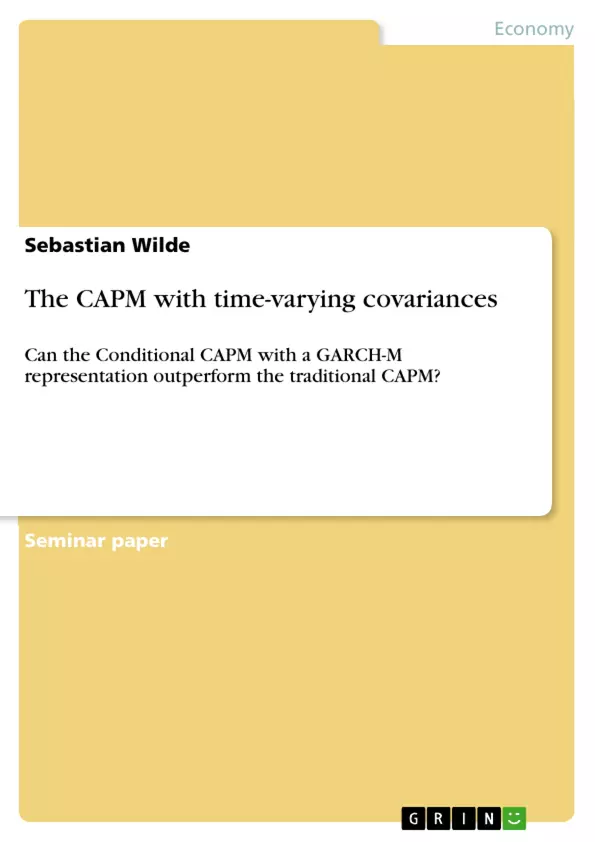The CAPM provides a single state, single factor, general equilibrium theory of the risk-return relation. However, in the 1960s, Mandelbrot (1963) already observed stock returns to have a very peaked distribution with heavy tails and also periods of persistent volatility, which contradicts the CAPM. In response to these observations, the Conditional CAPM (C-CAPM) has been discussed by several authors. In a C-CAPM investors can price an asset or portfolio conditional on the available information at a point in time. This is done by replacing the unconditional by conditional moments of returns. Statistically, processes of ”Generalized Autoregressive Conditional Heteroscedasticity” (GARCH) can capture the so called ”stylized facts”, some observed by Mandelbrot (1963). GARCH models were developed by Engle (1982) and Bollerslev (1986) and try to model time-varying second moments of asset returns. If a GARCH process is assumed for the disturbance term in a C-CAPM, a GARCH-in mean model (GARCH-M) can be estimated, where the conditional variance or covariance impacts the conditional expectation of (excess) returns. The GARCH-M can model time-varying conditional moments, but also time-varying risk premia and the implied beta factor. As for this seminar paper, I mostly follow the comprehensive dissertation ”Das CAPM mit zeitabhängigen Beta-Faktoren” of Linnenbrink (1998) and the paper of Bollerslev et al. (1988). First, the theoretical foundations of the CAPM, the C-CAPM, GARCH processes and the GARCH-M extension are presented. Then, in the empirical part, I estimate a (univariate) GARCH-M representation of the C-CAPM. I compare its performance to a traditional CAPM with a single stock portfolio of an investor (selected stock: Tesla, Inc.).
Inhaltsverzeichnis (Table of Contents)
- Literature review and introduction
- Theoretical foundation
- The traditional CAPM
- The flaws of the traditional CAPM
- The Conditional CAPM
- The (G)ARCH model foundations
- The GARCH-M extension
- Empirical analysis
- Econometric approach and methods.
- Data description
- Descriptive analysis and tests
- Model estimates.
- Conclusions
Zielsetzung und Themenschwerpunkte (Objectives and Key Themes)
The seminar paper aims to investigate whether the Conditional CAPM (C-CAPM) with a GARCH-M representation outperforms the traditional CAPM in evaluating the pricing of risky assets. This analysis focuses on the theoretical foundations of the CAPM, C-CAPM, GARCH processes, and the GARCH-M extension, followed by an empirical investigation of a GARCH-M representation of the C-CAPM.
- Evaluation of the CAPM and its limitations
- Understanding the theoretical framework of the C-CAPM
- Application of GARCH-M models to capture time-varying covariances
- Empirical comparison of the C-CAPM with GARCH-M representation to the traditional CAPM
- Assessing the performance of different models in pricing risky assets
Zusammenfassung der Kapitel (Chapter Summaries)
- Literature review and introduction: This chapter provides an overview of the Capital Asset Pricing Model (CAPM) and its limitations, highlighting the observed stylized facts of asset returns that contradict the traditional CAPM's assumptions. It introduces the Conditional CAPM (C-CAPM) and the GARCH-M model as potential solutions to address these limitations.
- Theoretical foundation: This chapter dives into the theoretical foundations of the traditional CAPM, outlining its key assumptions and the Markowitz portfolio selection approach. It also introduces the flaws of the traditional CAPM and the development of the C-CAPM, emphasizing the role of conditional moments in asset pricing. The chapter further explains the GARCH model and its extension, the GARCH-M, highlighting their ability to capture time-varying risk premia and beta factors.
- Empirical analysis: This chapter outlines the econometric approach and methods used in the empirical analysis. It discusses data description, descriptive analysis, and model estimates. This chapter focuses on the estimation and comparison of the GARCH-M representation of the C-CAPM with the traditional CAPM.
Schlüsselwörter (Keywords)
The seminar paper focuses on the Capital Asset Pricing Model (CAPM), Conditional CAPM (C-CAPM), GARCH models, GARCH-M models, time-varying covariances, risk premia, beta factors, asset pricing, stylized facts, and empirical analysis. These concepts are crucial for understanding the relationship between risk and return in financial markets and exploring alternative models for pricing risky assets.
- Citation du texte
- M.Sc. Sebastian Wilde (Auteur), 2021, The CAPM with time-varying covariances, Munich, GRIN Verlag, https://www.grin.com/document/1267030



